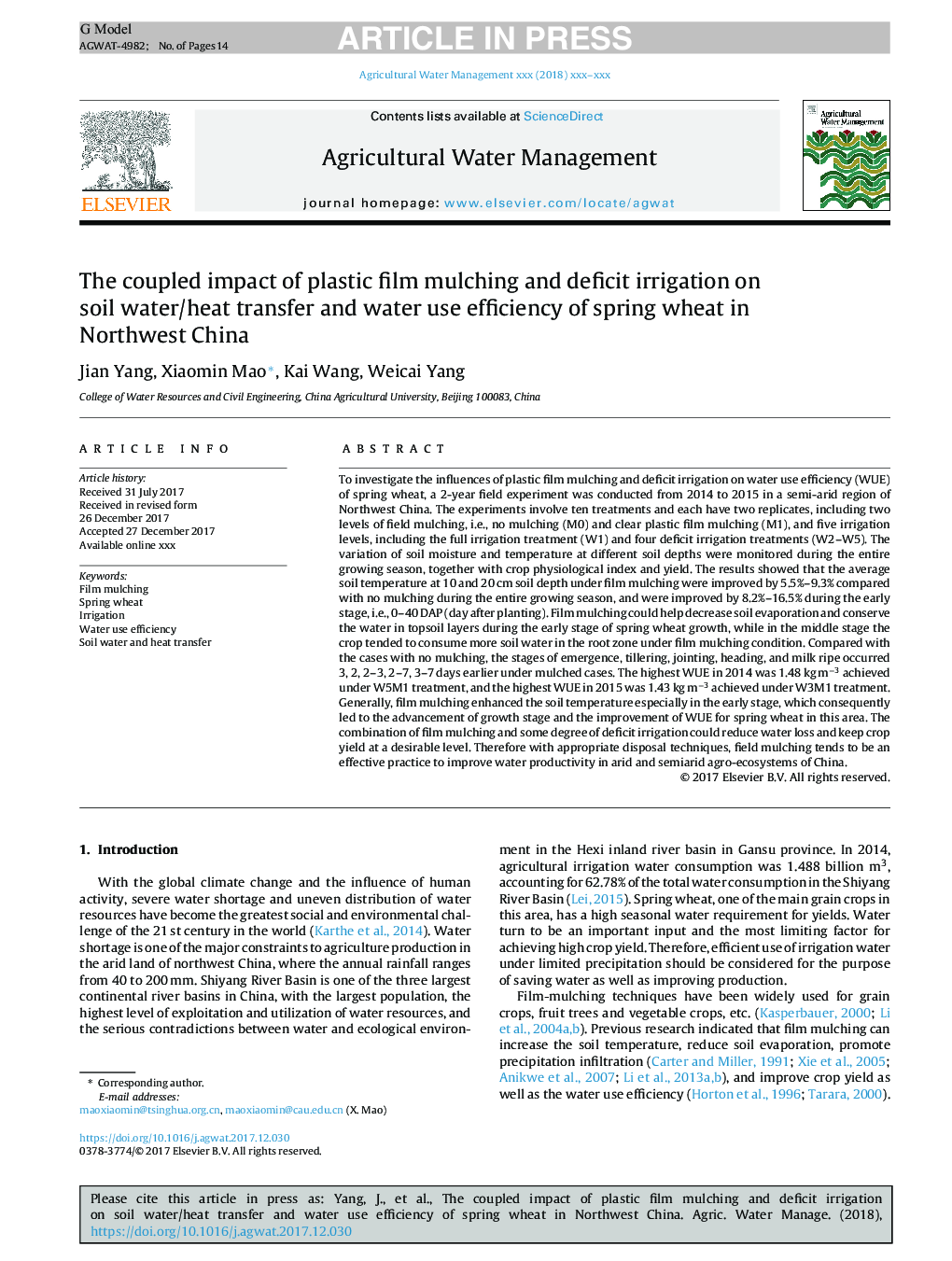| کد مقاله | کد نشریه | سال انتشار | مقاله انگلیسی | نسخه تمام متن |
|---|---|---|---|---|
| 8873088 | 1622879 | 2018 | 14 صفحه PDF | دانلود رایگان |
عنوان انگلیسی مقاله ISI
The coupled impact of plastic film mulching and deficit irrigation on soil water/heat transfer and water use efficiency of spring wheat in Northwest China
ترجمه فارسی عنوان
اثر متقابل آبیاری مالچ و فیلم پلاستیکی بر انتقال خاک و انتقال حرارت و بهره برداری از آب گندم بهاره در شمال غربی چین
دانلود مقاله + سفارش ترجمه
دانلود مقاله ISI انگلیسی
رایگان برای ایرانیان
کلمات کلیدی
فیلم مالچ گندم بهار، آبیاری، بهره وری استفاده از آب، انتقال آب و خاک به خاک،
موضوعات مرتبط
علوم زیستی و بیوفناوری
علوم کشاورزی و بیولوژیک
علوم زراعت و اصلاح نباتات
چکیده انگلیسی
To investigate the influences of plastic film mulching and deficit irrigation on water use efficiency (WUE) of spring wheat, a 2-year field experiment was conducted from 2014 to 2015 in a semi-arid region of Northwest China. The experiments involve ten treatments and each have two replicates, including two levels of field mulching, i.e., no mulching (M0) and clear plastic film mulching (M1), and five irrigation levels, including the full irrigation treatment (W1) and four deficit irrigation treatments (W2-W5). The variation of soil moisture and temperature at different soil depths were monitored during the entire growing season, together with crop physiological index and yield. The results showed that the average soil temperature at 10 and 20â¯cm soil depth under film mulching were improved by 5.5%-9.3% compared with no mulching during the entire growing season, and were improved by 8.2%-16.5% during the early stage, i.e., 0-40 DAP (day after planting). Film mulching could help decrease soil evaporation and conserve the water in topsoil layers during the early stage of spring wheat growth, while in the middle stage the crop tended to consume more soil water in the root zone under film mulching condition. Compared with the cases with no mulching, the stages of emergence, tillering, jointing, heading, and milk ripe occurred 3, 2, 2-3, 2-7, 3-7â¯days earlier under mulched cases. The highest WUE in 2014 was 1.48â¯kgâ¯mâ3 achieved under W5M1 treatment, and the highest WUE in 2015 was 1.43â¯kgâ¯mâ3 achieved under W3M1 treatment. Generally, film mulching enhanced the soil temperature especially in the early stage, which consequently led to the advancement of growth stage and the improvement of WUE for spring wheat in this area. The combination of film mulching and some degree of deficit irrigation could reduce water loss and keep crop yield at a desirable level. Therefore with appropriate disposal techniques, field mulching tends to be an effective practice to improve water productivity in arid and semiarid agro-ecosystems of China.
ناشر
Database: Elsevier - ScienceDirect (ساینس دایرکت)
Journal: Agricultural Water Management - Volume 201, 31 March 2018, Pages 232-245
Journal: Agricultural Water Management - Volume 201, 31 March 2018, Pages 232-245
نویسندگان
Jian Yang, Xiaomin Mao, Kai Wang, Weicai Yang,
